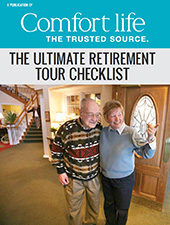Gene and the Mayo Clinic – Watching A Small Miracle
Brain health is ‘in’ nowadays.There are thousands and thousands of online programs, DVD’s, books and workshops. The reason is obvious. As Baby Boomers age, they are watching their parents’ generation dealing with diseases like Alzheimer’s and dementia and they start getting worried about their own ‘senior moments’ when they confuse their Facebook password and their on-line banking log-in.

As vice-president of Qualicare Homecare, I’ve encouraged our Nurse Managers and caregivers to engage our clients in brain stimulation activities, but never felt a standardized program of brain health was worth the investment – for our clients or in general.
Until I went to the Mayo Clinic with Gene.
Shock Treatment Side Effects
Gene is one of our clients (whose identity I’m obviously concealing). A very successful businessman, he was suffering from severe unrelenting depression. With the guidance and direction of a dear friend who is a renowned physician, it was decided that the best facility to address Gene’s condition was the famous Mayo Clinic and, specifically, the Department of Psychiatry. There they determined that the only course of action for him was ECT (electroconvulsive therapy).
As his Case Manager, I was in charge of coordinating and managing all of his healthcare needs. To that end, I carried his complete chart with us to the beautiful city of Rochester, Minnesota for an extended period of ECT therapy.
In my earlier life as a hospital nurse, I attended many ECT sessions and knew that immediately after treatment, patients exhibit confusion and memory loss. This can last a long time after treatment and is very difficult and frustrating for both patient and their family. I also knew that hospitals generally do not provide post-treatment recommendations (other than to rest it off) nor do they provide the family with any direction of how to help their loved one recover their memories.
A Post-ECT Treatment Program Evolves
As Gene’s case manager/caregiver, I decided to develop my own program of post-ECT ‘reawakening’. I used my experience in developing care plans for our clients with brain function deficiencies. And I made up a lot of it as I went along.
Pretty soon I had a routine in place. In the days and hours before each session (they were as frequent as three times a week) I made a point of engaging in memorable experiences with Gene. We would visit a specific place like the hospital gardens, play games in the outdoor activity area or work on jigsaw puzzles.
On treatment days, once he was back in his room, he always wanted to me to take him through the sequence of events that had brought him into hospital and how his family was coping. While we did the review, he would eat the breakfast that I had brought in and I guided him to appreciate the variety of flavors, aromas and textures that reawakened his senses.
I would then begin to remind him of what we had done in the previous days in order to stimulate his short term memory. It bothered Gene immensely to feel confused, as he was a person who was always completely in control. So at the moment when he would remember the event in the garden, or the new game we’d learned, his eyes lit up and he broke into a big smile. It was always such a joy when he was ‘back’.
Re-awakenings Accelerate
Initially, it took many hours for Gene to recover. But his eagerness and will power was so strong and the stimulation so effective that within one week, we were able to have him back to ‘normal’ in less than two hours after his treatment. The nurses on the ward would watch in awe at what was happening because they had never seen this before. The doctors in the Psychiatry and Neurology Departments heard what was happening and would come by to see Gene in action. As time went on, I added more neuro-aerobic activities, such as sorting, sequencing, building structures in order to help ignite his brain function and improve his self-confidence.
Lessons Learned
Watching this miracle, I started to think of my other clients. I realized that the general principles and some of the specific activities in Gene’s treatment program had a much broader application. I realized that any standardized brain health program was of limited effectiveness because it didn’t take into account the background and abilities of the individual patient.
Gene came from Poland and had little formal education and limited fluency in English. Written puzzles and assessment tests had limited effectiveness. That’s why I tended to use exercises using sensory stimuli like taste and hearing. Most of the commercially available brain health programs presuppose good language skills.
The cultural connection cannot be over-emphasized. One of the doctors in the department was also Polish. He was the only person Gene instantly recognized following a treatment. That connection transcended the disruption the ECT caused in his brain patterns. So it made sense to use Polish music or art for stimulation.
Gene put tremendous personal demands on himself once his series of ECT treatments were completed, working incredibly hard on the exercise program and neuro-aerobic activities I selected until he achieved a state of normalcy. But his brain was like a balloon getting bigger and bigger as he internalized all the new stimuli. I realized the importance of incorporating some gentle relaxation techniques at the end of our sessions to reduce the pressure on the balloon and allow everything to come together gently.
Finally, I realized that he achieved this quick ‘reawakening’ because he had a facilitator who was familiar with him. I believe effective brain stimulation needs to be done by people who intimately know the person they’re working with. The best facilitators are family/loved ones or a case manager like me.
So I am now a strong believer in ‘brain elasticity’ and the ability of a structured series of exercise to achieve positive results in both prevention and treatment of cognition challenges.
But to be most effective, these must be achieved with a holistic personalized approach.
Written by Andrea Nathanson, Executive Director of Qualicare

Author Bio
Andrea Nathanson is the Co-Founder of Qualicare Homecare and the Executive Director with primary responsibility for creating and maintaining Qualicare’s nurse-managed approach to homecare. A native of Vancouver, Andrea is a Registered Nurse, author and the main source of the unique energy that infuses Qualicare. She and her husband, Wayne, founded Qualicare in 2001 as a result of their difficult experiences caring for Wayne’s late father Nardy, who had ALS. They realized that there had to be a better way to help families cope with the multiple challenges of caring for loved ones. In 2011, they began to expand this approach across Canada and the US by creating Qualicare Franchise Corporation. Andrea can be reached at [email protected].
* * * * *
Do you think that the senses of sight, smell and sound can help unlock memories? Share your thoughts in the Comments section below.
Related Resources:
Senior Care Portrait: Have High Expectations
Healthy Minds
5 Ways to Reduce Risk of Alzheimer's Disease


